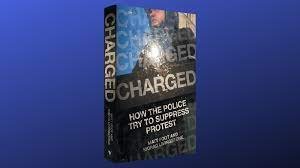Title: CHARGED – how the police try to suppress protest
Authors: Matt foot and Morag Livingstone
Publisher: Verso
Oppressive States, whether totalitarian or democratic, often resort to oppressive means and draconian laws to stifle dissent and outlaw protest. Draconian laws need police to enforce them, and to suppress those engaged even in peaceful protest.
Historically it is not difficult to find examples of regimes cracking down on protest by deploying police, militia or even the army to arrest, charge and imprison, and we can also see contemporary examples today in Hong Kong, China, or Putin’s Russia.
All of these recent examples have been criticised (and rightly so) by the U.K. government.
And yet at the same time, this Government has been enacting it’s own latest set of illiberal measures to deter protest by criminalising those that participate via The Police Crime Sentencing and Courts Bill 2021.
This Act contains a number of core proposals that “pose a significant threat to the UK’s adherence to its domestic and international human rights obligations, while also lacking an evidential basis to justify their introduction” (Justice, https://justice.org.uk/police-crime-sentencing-and-courts-bill/ ) and has attracted serious criticism from Liberty and Amnesty amongst others.
The Bill is only the latest in a perpetual and evolving battle between Government authority, and those who wish to exercise what even this Government purports to recognise as the “democratic right to protest”.
The Government makes laws- those are political decisions.
The Courts interpret the laws- those are judicial decisions.
And the police enforce the law. But is the policing of protest an operational or policing decision, or itself political?
Superficially it seems that sometimes the police can’t win-at least so far as the tabloid media and some MPs are concerned.Within a short space of time the Met police were being criticised for being too “hands-off” in policing XR or Black Lives Matter protests, and then too “heavy-handed” at the Sarah Everard protest.
But anyone who has been fooled into thinking that the Police are just helpless pawns doing their best in impossible circumstances, needs to take a read of ”Charged” by Foot/Livingstone, a well researched, impressive and above all readable account of the relationship between the police and those that they police.
As the full title suggests , this book does not hold it’s punches in setting out and taking to task the role that the police have carved for themselves in actively suppressing protest. Much of this has been done in secret, and therefore without political accountability as the book’s introduction makes clear, highlighting the secret deals conducted by the Home Office and ACPO. The authors have examined recently de-classified documents that catalogue the deliberate, planned but secret shift in policing tactics in the early 80s, and in stark hypocritical contrast to the recommendations of Lord Scarman’s report for better Community policing. It was also an extension of the secretive and equally unaccountable surveillance techniques, some of the implications of which are only now coming to light in the Undercover Policing Inquiry (aka the “spy cops scandal”)
The book is divided into 4 parts, dealing sequentially with the Thatcher era (industrial unrest and the “poll-tax riot”) , the 1990s, the “New Labour (tough on crime!)” years and a shorter final section (“Austerity Justice”)
These are book-ended by a foreword by Michael Mansfield QC (“the real agenda….is to ensure that any effective public expression is circumscribed…” and the concluding chapter (‘State of Play”)
I have attended protests as a legal observer, as well as acting for those who have been accused of offences arising from participation in public protest, and I know this book will appeal to those with similar experiences because this book shows there is much to learn even for seasoned protest veterans.
Equally, I recognise that there are those who have never been on a “demo”, and whose views may be formed either from having experienced some inconvenience from a protest, or what they have read or seen on media reports. Such media coverage is heavily influenced by police accounts, and often wholly inaccurately (many examples of which are cited here, particularly e.g. the misreporting of police officers assaulting striking miners at Orgreave, 1984). This book therfore is an invaluable corrective to such misconceptions, and should appeal to social historians as much as lawyers or criminologists.
The concluding chapter effectively summarises the last 40 years of policing protest, where we are now, and gives a nod to the future (“ the long history of protest confirms that dissent always returns despite efforts of the State to suppress it’)
Are they right? Or will over-zealous policing make it impossible to demonstrate or protest without frisking getting ”charged“ , criminalised and sanctioned.
Let’s see what the authors have to say in the follow-up book (which I warmly anticipate) in 10 years or so. I applaud the writers for presenting a detailed account of where we are now and why in a way that makes this book a pleasure to read, and recommend it to lawyers and non-lawyers alike.
